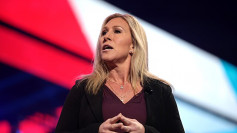U.S. President Joe Biden launched a two-day virtual Earth Day Summit with a promise to cut U.S. emissions in half by the end of the decade.
In his opening remarks, Biden said: "Time is short, but I believe we can do this."
The new commitment, announced by the White House April 22, Earth Day, aims to cut the country's carbon emissions by at least half by 2030 based on 2005 levels.
The ambitious target set the tone for a summit that brought leaders from more than 40 countries as the coronavirus pandemic rages, accompanied by economic uncertainty.
According to U.S. officials, the purpose of the Earth Day gathering is to highlight the urgency of climate action as well as the economic benefits of investing in renewable energy while mitigating the devastating effects of global warming.
Dozens of world leaders started to share their assessments of climate-related threats, explaining ongoing strategies and announcing new measures to achieve net-zero emissions by 2050.
Following weeks of pressure from subnational officials, scientists and the private sector, the Biden administration has made a new commitment for the current decade.
Ursula von der Leyen, President of the European Commission, shared new information on the European Union's climate law, which was passed Wednesday.
Boris Johnson, Prime Minister of the U.K., provided more information on the country's new goal of reducing emissions by 78% below 1990 levels by 2035.
Scott Morrison, the Prime Minister of Australia, unveiled a new net-zero target and energy innovation programs.
Canada, Japan and South Korea proposed new UN climate targets, as well as a ban on overseas coal financing.
As world leaders rushed through speeches at the summit, a new report cautioned that if climate change persists unabated and average temperatures rise 3.2 degrees Celsius above pre-industrial levels, the global economy could lose nearly a fifth of its economic production by 2050.
The Biden administration sees combating climate change as an opportunity to create jobs, such as installing wind and solar power, constructing electric vehicle charging infrastructure, and making homes and buildings more energy efficient.





